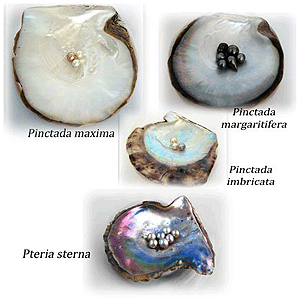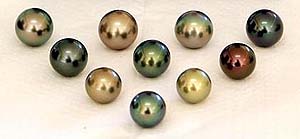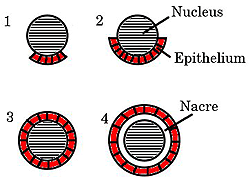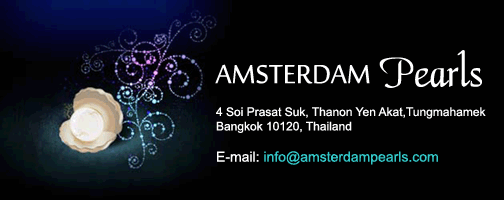|
|
 |
 |
|
Education |
South Sea Pearls
Among the largest in the world, South Sea
Pearls are among the largest commercially
harvested cultured pearls in the world. The
average size of a South Sea Pearl is 13 mm,
with most harvests producing a range of
sizes from 9 mm to 20 mm. The South Seas lie
between the northern coast of Australia and
the southern coast of China. These waters
are the native habitat of a large oyster
known as Pinctada Maxima. This oyster grows
up to 12 inches in diameter, and can be
nucleated with a much larger bead than other
saltwater oysters such as the Akoya.
South Sea Pearls Come From Two Varieties Of
Pearl-Producing Mollusks
There are two varieties of Pinctada Maxima,
the silver-lipped and the gold-lipped. The
two are distinguished by their distinct
coloration of the outer edge of the
interior. |
This type of shell is also known as
mother-of-pearl, and is responsible for the
coloration of the cultured pearls produced,
therefore the name. Unlike the Akoya Oyster,
the South Sea Oyster will only accept one
nucleation at a time. The oyster is
nucleated when it is only about half
developed, from 4.7 inches to 6.7 inches in
size, or about 24 months old. Although the
South Sea Oyster will only handle one
nucleus at a time, this oyster (like the
Tahitian pearl producing Pinctada
Margaritifera) can be nucleated up to three
times over the course of many years.
Why South Sea Pearls grow so large
There are four reasons South Sea Pearls can
grow to such large sizes, dwarfing many of
their other saltwater pearl counterparts:
- The
large size of the Pinctada Maxima
- The size
of the implanted bead
- The
length of time the pearl is left to grow
in the oyster
- And the
oyster’s environment.
|
 |
 |
Due
to the size of the oyster, it is
able to accept a large bead. The
gonad of the Pinctada Maxima is
several times larger than that
of the Akoya. Because of this
larger gonad, the South Sea
Oyster deposits nacre around the
nucleus at a much quicker rate,
especially in warm water, which
speeds the oyster’s metabolism.
The South Seas are also
extremely clean and filled with
plankton - the Pinctada Maxima's
favorite food source. The clean
waters and abundant food supply
also speeds the nacre
production. The growth period
for South Sea pearls is also
substantially longer than that
of the Akoya. Akoya Pearls are
harvested after only 9 - 16
months, whereas South Sea Pearls
are harvested after a minimum of
two years, allowing for a larger
size.
South Sea Pearls have several
distinct characteristics that
are unique to this gem. The
nacre is unusually thick,
ranging from 2 - 6 mm, compared
to the 0.35 - 0.7 mm of an Akoya
Pearl. South Sea Pearls have a
unique, satiny luster that comes
from the rapidly deposited nacre
and warm waters of the South
Seas. South Sea Pearls also have
a subtle array of colours -
typically white, silver, and
golden - that are rare in other
pearl types. |
Tahitian Pearls
Among The most beautiful In the world,
Tahitian Pearls are produced in the
black-lipped oyster ‘Pinctada Margaritifera’,
in and around Tahiti and the French
Polynesian islands. This oyster itself is
quite large - sometimes over 12 inches
across and weighing as much as 10 pounds -
which often results in much
larger-than-average pearls. The pearls are
unique because of their natural dark colors.
Most "black" Tahitian Pearls are not
actually black, but are instead silver,
charcoal, or a multitude of colors with the
dominant color being green. Truly black
pearls are among the most beautiful pearls
in the world, and are extremely rare. |
 |
 |
Almost Hunted To Extinction
Not only are the
pearls beautiful, but the black-lipped
oyster's mother-of-pearl inner shell is also
extremely attractive. By the early part of
the 20th century, before conservation and
repopulation efforts began, the Tahitian
Pearl Oyster had almost been hunted to
extinction for its shell alone.
Tahitian Pearls - Not From
Tahiti
Although Tahitian
Pearls are thought by many to be
solely a product of Tahiti, this
is in fact not true. |
Tahiti is the commercial center
and trading hub for the bulk of
the industry, however Tahiti
does not have any pearl farms
actually located on the island.
The
farms are instead scattered
throughout French Polynesia, as
far east as the Gambier Islands,
and beyond French Polynesia to
the west into the Micronesian
Islands. Australia, the
Seychelles and Vietnam have all
produced black pearls as well,
but those cannot be referred to
as Tahitian pearls.
Tahitian Pearl Farming Begins
Tahitian Pearl
farming has much later commercial origins
than its other cultured pearl cousins. In
the early 1960's a man by the name of
Jean-Marie Domard began experimenting with
the ‘Pinctada Margaritifera’ using Japanese
culturing techniques. In 1962, Mr. Domard
successfully nucleated 5,000 oysters, and
after 3 years harvested more than 1,000
high-quality Tahitian Pearls. |
What Are Akoya Pearls?
Akoya Pearls are cultured in the Pinctada Fucata
Martensii, also known as the Akoya
Oyster. This mollusk is found and farmed
primarily in Japan and China. Renowned for
their luster, Akoya are considered the
classic pearl. They are generally white or
cream colored, with overtone colors of rose,
silver, or cream.
Akoya Pearls, The Perfect Pearl For
Jewelry
The Akoya Oyster is the smallest
pearl-producing oyster used in pearl culture
today, so Akoya Pearls also tend to be
small, ranging in size from about 2 to 11
millimeters. They also tend to be the most
consistently round and near-round pearls,
making them ideal in terms of matching for
multi-pearl jewelry such as strands and
bracelets. |
China Overtakes Japan
In recent years the Chinese have overtaken
the Japanese in Akoya Pearl production. The
Chinese began culturing Akoya Pearls in the
1960's, but had limited success until the
late 1980's. While once considered inferior
to their Japanese counterparts, China is now
producing Akoya Pearls of qualities that
rival that of the Japanese in every quality
factor.
Japanese Industry Reaction
Due to
the increased pressure of the Chinese
competition, many Japanese pearl farmers
have focused much of their attention on
culturing large Akoya Pearls, as quality Akoya
Pearls larger than 8 mm are a rare
find in China. |
 |
 |
In lieu of farming smaller
pearls, many Japanese factories now import
their smaller Akoya requirements from
neighboring China. The pearls are treated
and strung in Japan so that they may still
carry the mark 'Product of Japan'. It has
been reported that more than 80% of the
pearls 7 mm and smaller have come from
Chinese farms regardless of whether or not
they are sold by Japanese suppliers as
Japanese pearls.
Where do Freshwater Pearls come from?
Although the traditional source
of pearls has been saltwater
mollusks, freshwater mussels,
which live in ponds, lakes and
rivers, can also produce pearls.
China has harvested freshwater
pearls in the form of maybe
since the 13th century, and has
now become the world's
undisputed leader in freshwater
pearl production. The first
record mentioning pearls in
China was from 2,206 BC. The United States
were also a major
source of natural freshwater pearls, from
the discovery of the New World through the
19th century, until over-harvesting and
increasing pollution significantly reduced
the number of available pearl-forming
mussels in the US. |
 |
 |
The Appeal of Freshwater Pearls
Generally speaking, Freshwater Pearls are
not as round as Saltwater Pearls, and they
do not have the same sharp luster and shine
as Akoya Pearls.
However, they appear in a
wide variety of shapes and natural colors,
and they tend to be less expensive than Saltwater
Pearls, making them very popular
with younger people and designers. Also,
because freshwater pearls are solid nacre,
they are also quite durable, resisting
chipping, wear, and degeneration. |
China leads the World in
Freshwater Pearl Production
With a total production of 1,500
tons in 2006, China holds a
monopoly over the freshwater
pearl industry today. Although
the birth of the Chinese
freshwater pearl industry is
traced back to the area around
Shanghai, freshwater pearls are
now produced in all the
surrounding provinces including
Zhejiang, Anhui, Jiangsu, Hubei,
Hunan, and Jianxi. Local pearl
trade is conducted mainly in the
cities of Zhuji (Shanxiahu),
Suzhou, Wuxi, Wenling, and
Weitang. The largest marketplace
for these freshwater pearls is
the world's pearl trading hub,
Hong Kong.
Videos
In this section there are some
very interesting videos about
pearls, excellent for pearl
passion transfer, essential for
pearl education. / In deze
sectie belangrijke vdo's die
heel veel laten zien over het
verleden (Jewelmer vdo), het
huidige groei process, de oogst,
het sorteren, matchen,
verhandelen,etc. Goed om parel
passie te verkrijgen.
1. Dominique Petras about her
Tahitian pearl passion /
Dominique Petras, over haar
passie voor Tahiti parels.
http://www.youtube.com/watch?v=bXXpDA6p3Z8&feature=channel&list=UL
2. A DVD about the Golden
Pearls, how they grow,etc from
Jewelmer in the Philippines,
world best supplier of these
South Sea pearls. / DVD over de
gouden parels van Jewelmer in de
Filipijnen, waar de allermooiste
goudkleurige parels uit de
Pinctada Maxima oester komen.
http://www.youtube.com/watch?v=04Hw9_8i4Wg&feature=BFa&list=ULSbUS7wOPYUE
3. DVD about how pearls are
auctioned, here one of Robert
Wan from Tahiti in Hong Kong. /
DVD over een veiling van parels
van Robert Wan (Tahiti parels
http://www.youtube.com/watch?v=o32qHAYRPAk&feature=relmfu
4. Latest developments in
freshwater pearls from China. /
De laatste ontwikkelingen van
zoetwater parels in China.
http://www.youtube.com/watch?v=5LdXS1HeRo4&feature=BFa&list=ULLbAlf_DGWUQ
5. DVD about the growing process
of fresh water pearls from
China. / DVD over het laten
groeien van parels in China.
http://www.youtube.com/watch?v=VmC_kxvS334&feature=related
6. 4 DVD's from Fran Mastoloni,
a prominent generation old
retailer of pearls in New York
about growth, sorting and
matching, pearl value and the
various shapes. / 4 DVD’s van
Mastoloni, een toonaangevende
parel juwelier uit New York,
over het groeien, sorteren,
matchen, de waarde bepaling , de
vormen en de 5 bepalende
faktoren en vooral de laatste
DVD is zeer interessant vanwege
de uitleg over alle gangbare
parels uit verschillende oesters.
http://www.youtube.com/watch?v=DhI96cT4vcA&feature=related
http://www.youtube.com/watch?v=qt8LLyRBeeo&feature=relmfu
http://www.youtube.com/watch?v=BaDyPOeHd2o&feature=relmfu
http://www.youtube.com/watch?v=0Hbws7GsB6Q&feature=related |
|
|
 |
|
|
|
© 2012 Amsterdam Pearls |
|
|

